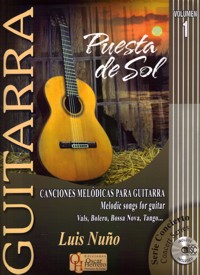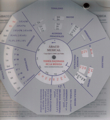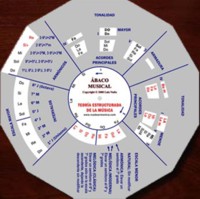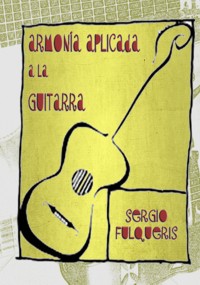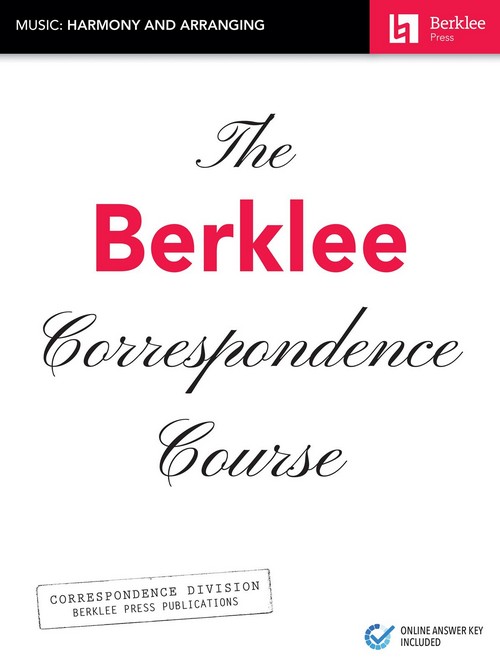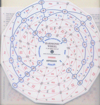
Harmonic Wheel
Nuño, Luis
Luis Nuño Fernández. 2008Ficha técnica
- EAN: 9788461230105
- ISBN: 978-84-6123010-5
- Editorial: Luis Nuño Fernández
- Fecha de edición: 2008
- Encuadernación: Plástico
- Dimensiones: 23x23
- Idioma: Inglés
- Nº páginas: -
Agotado
Agotado en la editorialPVP. 20,00€
Añadir a la Lista de deseos
The new instrument of musicians.
As every art, the practice of Music requires some creative skills as well as a good sense of aesthetics and proportion. Moreover, in most cases it requires a good interpretative talent. And finally, it requires a technical, even mathematical, knowledge, which deals with intervals, scales, keys, chords, arpeggios, etc., all of which confers the music a distinctive character with respect to the rest of the arts.
The study of this technical part usually takes several years and, frequently, it is not learnt in an orderly and unified way. On the contrary, it is viewed as a set of independent subjects, without any logical relationship among them. Questions such as "the order of sharps and flats" or "the particular step and half-step sequence in a Major scale" are learnt by heart and only in a few cases the reason is understood. On the other hand, many concepts that, in Music Theory and Harmony, are perfectly understood in the C Major key, are not so obvious when dealing with key signatures having 5 or 6 alterations.
With the objective of sorting out all those technical contents, as well as to facilitate the use of keys with an arbitrary number of alterations, the so called HARMONIC WHEEL has been designed, a new easy-to-use instrument which contains a large quantity of detailed musical information.
The Harmonic Wheel has been presented in several Conservatories and Musical Societies, as well as in specialized music stores, and it has been greatly appreciated.
WHAT IS THE HARMONIC WHEEL?
The Harmonic Wheel is a new representation of Sounds, where the Consonance Relationships among them are clearly shown. It is, therefore, a powerful tool for the comprehension of Music Theory and Harmony.
The Harmonic Wheel has been developed by considering 2 kinds of Consonant Relationships: Consonant Intervals (2 note consonances) and Consonant Chords (3 note consonances).
As it is based on the most fundamental relationships among sounds, its application field covers the different musical styles: classical music, modern music, jazz, latin music, etc. Moreover, it is designed in such a way that, in order to use it, it is not necessary to be able to read music.
Its final design consists of two rotating discs, being one cardboard and the other plastic. It comes with instructions, examples of use and a practical protective cover.
SUMMARY OF APPLICATIONS
The HARMONIC WHEEL has many practical applications, most of which are described in the next chapters. A non-exhaustive listing of the principal questions that can be solved with this powerful and versatile abacus is included below.
1) Enharmonic notes and chords.
2) Given a note, obtaining the 6 notes with which it forms consonant intervals.
3) Obtaining the interval between any two notes.
4) Notes of every Major Scale.
5) Notes of every minor Scale (harmonic, melodic or natural).
6) Key Signature of any Major or minor Scale.
7) Map of the Keys: Cycle of Fifths and Changes of Mode.
8) Arpeggios of any Major or minor chord.
9) Given a note, obtaining the 6 consonant chords (Major and minor) containing it.
10) Arpeggios of any augmented or diminished chord.
11) Simple graphical representation of all possible 3 and 4 note chords built by superimposing Major and minor thirds. Finding their arpeggios.
12) Chord Finder: Chords associated to any Major or minor scale (harmonic, melodic or natural).
13) Graphic visualization of the chords which are near to or far from a given scale.
14) Transposition of a chord progression.
15) Simple graphical representation of Pentatonic Scales and deriving their main properties.
16) Simple graphical representation of diminished and Hexatonic Scales. Finding their associated chords.
---



